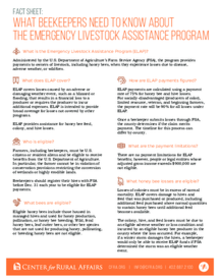Para la versión en español, por favor oprima aqui.
What is the Emergency Livestock Assistance Program (ELAP)
Administered by the U.S. Department of Agriculture’s Farm Service Agency (FSA), the program provides payments to owners of livestock, including honey bees, when they experience losses due to disease, adverse weather, or wildfires.
What does ELAP cover?
ELAP covers losses caused by an adverse or damaging weather event, such as a blizzard or flooding, that results in a financial loss to a producer or requires the producer to incur additional expenses. ELAP is intended to provide broad coverage for losses not covered by other programs.
ELAP provides assistance for honey bee feed, colony, and hive losses.
Who is eligible?
Farmers, including beekeepers, must be U.S. citizens or resident aliens and be eligible to receive benefits from the U.S. Department of Agriculture. In particular, the farmer cannot be in violation of conservation provisions restricting the conversion of wetlands or highly erodible lands.
Beekeepers should register their hives with FSA before Dec. 31 each year to be eligible for ELAP payments.
What bees are eligible?
Eligible honey bees include those housed in managed hives and used for honey production, pollination, or honey bee breeding. Wild, feral honey bees, leaf cutter bees, or other bee species that are not used for producing honey, pollinating, or breeding honey bees are not eligible.
How are ELAP payments figured?
ELAP payments are calculated using a payment rate of 75% for honey bee and hive losses. For socially-disadvantaged (producers of color), limited resource, veteran, and beginning farmers, the payment rate will be 90% for all losses under ELAP.
Once a beekeeper submits losses through FSA, the county determines if the claim merits payment. The timeline for this process can differ by county.
What are the payment limitations?
There are no payment limitations for ELAP benefits; however, people or legal entities whose adjusted gross income exceeds $900,000 are not eligible.
What honey bee losses are eligible?
Losses of colonies must be in excess of normal mortality. ELAP covers damage to hives and feed that was purchased or produced, including additional feed purchased above normal quantities to sustain honey bees until additional feed
becomes available.
The colony, hive, and feed losses must be due to an eligible adverse weather or loss condition and incurred by an eligible honey bee producer in the county where the loss occurred. For example, if a winter storm damages the hives, a beekeeper would only be able to receive ELAP funds if FSA determined the storm was an eligible weather event.
What about Colony Collapse Disorder?
ELAP covers colony losses, honey bee hive losses (the physical structure), and honey bee feed losses in instances where they have been destroyed by a natural disaster or, in the case of colony losses, because of Colony Collapse Disorder. Colony losses must be in excess of normal mortality.
If the honey bee colony loss was incurred because of Colony Collapse Disorder, program participants must provide a producer certification that the loss was a direct result of at least three of the five symptoms of Colony Collapse Disorder, which include:
- The loss of live queen and/or drone bee populations inside the hives;
- Rapid decline of adult worker bee population outside the hives, leaving brood poorly or completely unattended;
- Absence of dead adult bees inside the hive and outside the entrance of the hive;
- Absence of robbing collapsed colonies by other bees; and
- At the time of collapse, varroa mite and Nosema populations are not at levels known to cause economic injury or population decline.
How to apply?
Beekeepers should first make sure their hives are registered with FSA and that they have a farm number. This number can be assigned to the beekeeper or the land on which the hives are situated.
Beekeepers can apply to receive ELAP assistance at their local FSA offices. The application period ends Dec. 31 of each calendar year. A producer must file both a notice for loss and an application for payment to obtain benefits.
The date of loss must be within the program year, which runs from Jan. 1 to Dec. 31. Losses must be filed within 15 days after the loss is apparent.
Program participants who were paid for the loss of a honey bee colony or hive in either or both of the previous two years are required to provide additional documentation to show how current year inventory was acquired.
Tips from beekeepers about working with FSA:
- Not all FSA county offices will be equally familiar with the beekeeping portion of ELAP. Knowing counties that have more experience with ELAP for beekeepers can be helpful. In Nebraska, Cedar, Saunders, and Dodge counties have many beekeepers.
- Be sure to register your hives with FSA so they’re on record. This should happen any time the number of hives changes.
- Keep track of your records, including receipts for purchase of bees or sugar, so you can easily access them.
- Stick with the process, and follow up as much as you need to.
This project is funded by the Beginning Farmer and Rancher Development Program (BFRDP) of the U.S. Department of Agriculture’s National Institute of Food and Agriculture.


